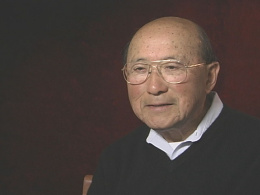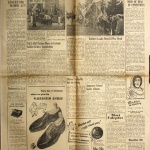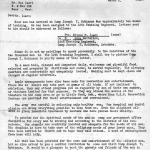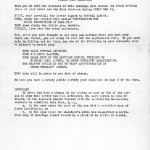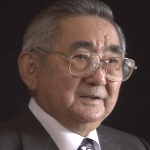Rescue of the Lost Battalion
Perhaps the most fabled episode in the history of the 100th Infantry / 442nd Regimental Combat Team (RCT), the rescue of the so-called Lost Battalion, took place in the Vosges Mountains in France at the end of October 1944. Members of the 1st Battalion of 141st Texas Regiment found themselves cut off and surrounded behind enemy lines with limited food and water. Ordered to rescue them, the 100th/442nd RCT, engaged in nearly nonstop combat for six days, eventually reaching the Lost Battalion on October 30. The 442nd suffered hundreds of casualties in rescuing 211 men. The rescue raised the question of whether the Nisei soldiers were being used as "cannon fodder" or whether they were given the most difficult assignments because of their outstanding performance.
The Battle
As the soldiers of the 36th Infantry Division, including the 100th/442nd RCT, pushed toward Germany in late 1944, they faced some of their heaviest resistance and harshest terrain in the Vosges Mountains of eastern France. It was in this dense forest and mountainous landscape that the 1st Battalion of the 141st Regiment, 36th Division, became "The Lost Battalion." For their part in this difficult region, at the end of October 1944 the Nisei had received a much deserved rest behind the lines after strenuous battles to liberate Bruyeres and Biffontaine, but it was to be a short-lived break.
On the front lines of the Allied assault, Major General John E. Dahlquist , commander of the 36th Division, pushed the unit—which was made up primarily of soldiers from Texas—forward to liberate more French territory. The men of the 141st moved quickly through the trees taking advantage of significant gains made by the Allies during the previous days and weeks of fighting. In their haste to recapture more territory, they unknowingly separated themselves from their fellow soldiers and became surrounded by German units. The 1st Battalion, under the leadership of Lt. Marty Higgins, lost contact with headquarters and the 2nd and 3rd Battalions made little headway in their attempts to reach their comrades. Members of the 405th Fighter Squadron of the 371st Fighter Group dropped supplies and food to the men, but as temperatures fell, rations decreased and the wounded deteriorated; the situation grew desperate for the men of the 1st Battalion.
General Dahlquist recalled the Japanese American soldiers of the 100th /442nd RCT from their rest behind the lines and they attempted to reach the surrounded unit, slogging through rain and mud for miles towards the Texans. The 100th Infantry and the 2nd and 3rd Battalions of the 442nd RCT fought diligently for five days with the help of the 522nd Field Artillery Battalion to break through or surround the Germans who entrapped the Texans. Pvt. George Sakato reported that the lines were often so close that when the American artillery was active, "we jumped into any hole that was open to keep from getting hit." [1] Members of their Antitank units joined in the effort as did soldiers from the 232nd Combat Engineer Company, all of whom hoped to break the stalemate that encircled the men of the 36th. Despite their best efforts and teamwork, the fighting was difficult, forcing the Nisei to fight tenaciously for every yard of ground gained. The men would later learn that Adolf Hitler himself had heard of the trapped unit and ordered that they not be rescued no matter what the cost on the German side.
Finally, six days after the Texans were surrounded, the Nisei approached from two sides, pushed back the German troops, and drew near the Lost Battalion. At some points during the battle the Nisei had been outnumbered by as many as four to one; one particular hill that witnessed a fierce bayonet charge led by Private Barney Hajiro came to be known as "Suicide Hill" due to the casualty rate of the advancing troops. According to Pfc. Ichigi Kashiwagi of K Company, "We yelled our heads off and charged and shot the head off everything that moved... we didn't care anymore... we acted like a bunch of savages." [2] Companies I and K of the 3rd Battalion emerged with only seventeen and eight infantrymen respectively and both were led by sergeants because all higher ranking officers and non-commissioned officers had been killed or wounded.
Following the strenuous hand-to-hand combat of October 29 and an artillery bombardment the morning of October 30, the battles finally eased for the 100th/442nd RCT, but the situation was still tense for the trapped Texans. As the rescuers came closer, the German artillery focused more on the Lost Battalion itself, which was already lacking supplies and losing soldiers every day. By midafternoon the Nisei were able to penetrate the German lines and caught sight of soldiers in American uniforms. In what has become a famous exchange, Mutt Sakumoto, the first Japanese American to reach the trapped soldiers, offered a cigarette to the men of the 36th when he found them. Ed Guy, one of the rescued soldiers recalled, "I might have hugged [Sakumoto], I don't know... I was just excited to get out of there." [3] The unit received a Presidential Unit Citation for their actions during the rescue, and nearly every man involved earned a Purple Heart and Bronze Star. Major Claude D. Roscoe of the 141st Regiment remembered the moment when they finally realized who their heroes were: "To our great pleasure it was members of the 442nd Combat Team. We were overjoyed to see these people for we knew them as the best fighting men in the ETO." [4]
The Nisei rescued the 211 Texans who remained of the 275 who had been surrounded. They suffered staggering casualty rates in the process and those companies who participated in the final push to reach the 141st averaged less than half their normal full strength after the battle. Throughout the difficult fighting of the campaign in Eastern France including the Rescue of the Lost Battalion, the 100th/442nd RCT faced a total of approximately 150 killed and 1,800 wounded. Just weeks after the rescue, General Dahlquist, who had removed them from their rest and forced the Japanese Americans into nine more days of heavy fighting during and after the rescue, ordered the 100th/442nd RCT to gather for a parade review. Dahlquist accused the Japanese Americans of not turning out for the required review because their numbers were so small, but the Nisei informed him that their ranks were small due to the high casualty rates of the preceding weeks thanks to his orders. While some historians have questioned whether the high casualty rates of the 100th/442nd RCT are reflective of their use as "cannon fodder," their success in the face of difficult odds in situations like the Rescue of the Lost Battalion goes a long way to disprove this argument.
The Legacy
The legacy of the Rescue of the Lost Battalion in the history of the 100th/442nd RCT cannot be overstated. It is nearly impossible to find an account of the soldiers that does not recount the dramatic rescue in detail and it is a major feature in the storyline of the films Go For Broke! (1951) and Only the Brave (2006). Barney Hajiro, James Okubo, and George Sakato were each awarded the Medal of Honor for their actions in the rescue, becoming three of the 20 Japanese Americans who received this honor in 2000. Perhaps one of the most anecdotal recognitions of the importance of this activity took place in 1962 when Texas Governor John Connally made all members of the 100th/442nd RCT "Honorary Texans" for their role in saving the lives of so many Texas soldiers. Many men of the two units have also kept in touch to honor their unique relationship, which was commemorated in Houston, Texas, in 2009 with the "Homecoming for Heroes" reunion of the 36th Division Lost Battalion and the 100th/442nd RCT. For any student of the Japanese American experience, the Rescue of the Lost Battalion is an essential part of the story, one which has arguably helped improve the reception of Japanese Americans in the United States in the years since World War II.
For More Information
Asahina, Robert. Just Americans: How Japanese Americans Won a War at Home and Abroad . New York: Gotham, 2006.
Crost, Lyn. Honor by Fire: Japanese Americans at War in Europe and the Pacific . Novato, CA: Presidio Press, 1994.
Duus, Masayo. Unlikely Liberators: The Men of the 100th and the 442nd . Honolulu: University of Hawaii Press, 1987.
McCaffrey, James M. Going for Broke: Japanese American Soldiers in the War against Nazi Germany . Volume 36 in the Campaigns and Commanders Series. Norman: University of Oklahoma Press, 2013.
100th Infantry Battalion Veterans Education Center: http://www.100thbattalion.org/ .
Only the Brave . Mission from Buddha Productions. Written and directed by Lane Nishikawa. 2006 99 minutes.
"Rescue of the Lost Battalion" from Go For Broke National Education Center website, https://goforbroke.org/rhineland-campaign-rescue-of-the-lost-battalion/
Steidl, Franz. Lost Battalions: Going for Broke in the Vosges, Autumn 1944 . Novato, CA: Presidio Press, 1997.
Tanaka, Chester. Go for Broke: A Pictorial History of the Japanese American 100th Infantry Battalion and the 442nd Regimental Combat Team . Richmond, CA: Go for Broke, Inc., 1981. Novato, CA: Presidio Press, 1997.
Yenne, Bill. Rising Sons: The Japanese American GIs Who Fought for the United States in World War II . New York: Thomas Dunne Books, 2007.
Last updated Jan. 30, 2024, 1:04 a.m..

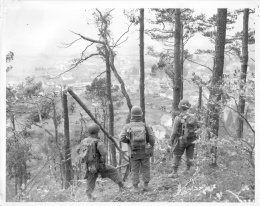 Media
Media
